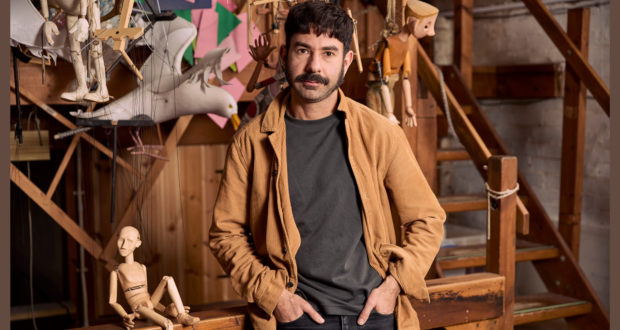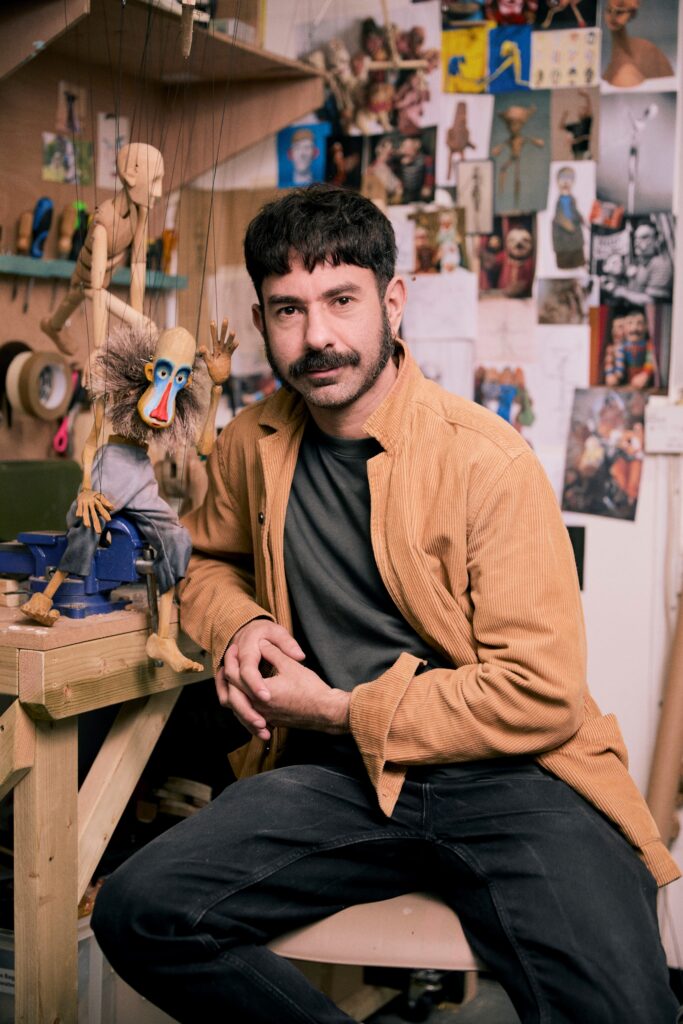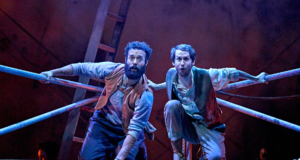Award-winning puppet artist Oliver Hymans on endangered marionettes
Marionette puppets have a history dating back centuries in the UK. The arrival of television meant they came to a wider audience, with one of the first children’s programmes starring the puppet called Muffin the Mule. Many of us grew up enjoying Thunderbirds, perhaps playing along and imitating the wobbly movements of the stringed characters as they saved the Earth from near certain destruction. These puppets themselves are iconic, but would they even be made in today’s world?
There are so few people left performing the craft of marionette making that it has recently been recognised as an endangered artform. We spoke with award-winning puppet artist Oliver Hymans about his quest to raise the precarious profile of marionette production and perhaps even save it from extinction.
To begin with Oliver, can you tell us about what is involved in crafting a marionette and the skills required?
There are some considerations involved in crafting a marionette which differ from other forms of puppetry. Character design aside, you must first define the puppet’s size followed by what the marionette specifically needs to do. There will be differences in the design as to whether the marionette is a ‘walking’ or ‘dancing’ puppet or if it is a trick puppet that needs to juggle, split apart or walk the tightrope etc. Each marionette tends to be great at doing one thing. The tradition has a rich history across the world and so, over hundreds of years, different puppet masters from different cultures have developed and created specific joints for their figures, along with hand controls which are unique to the maker.
Beyond these parameters, the puppet maker, traditionally, needs to have a good understanding of cutting and carving wood (principally Lime or Jelutong), and the ability to use a range of specialised tools safely. The final stage of the process, once the puppet is carved and jointed, is the stringing – anywhere between 9 strings on a typical European figure or up to 36 on a traditional Chinese marionette. For me, the stringing is the most exciting part – the anticipation of the puppet finally coming alive along with the fine tuning where a few milometers can completely change the whole balance of the puppet.
How many marionette makers are there presently in the UK?
Through my research with Heritage Craft, we estimated that there are probably between 1-5 professional makers whose main income is from this craft (either selling, commissions, conservation, restoration and/or teaching). The number of professional makers in the UK who create marionettes as a side line or as part of their main income is anywhere between 11-20. Of course, there will be many more serious amateur makers and UK leisure makers /learners, however as these numbers suggest, the pool of professional makers is dwindling, especially since many of these practitioners are in or nearing retirement.
And where might these puppets be performed?
The only place in the UK where you will consistently see marionette puppetry all year round is The Puppet Theatre Barge in London. Last Christmas the Norwich Puppet Theatre had a production of Cinderella which made use of their marionette bridge.
Why is it that fewer people are making marionettes these days?
There are several reasons: a lack of professional training opportunities, as well as a lack of opportunities to practice the craft with the few remaining teachers or practitioners. In order to practice with long string marionettes – the kinds presented, historically, at the Little Angel Theatre and Norwich Puppet Theatre, where the puppeteers are raised several metres off the ground above the stage – puppeteers require specific spaces to rehearse, and these are just not readily available.
There is also the argument to say that marionettes have fallen out of fashion in relation to other more popular forms of puppetry akin to that seen in large scale contemporary shows like War Horse, Life of Pi, My Neighbour Totoro etc. As mentioned above, an aging workforce means the art form risks dying out, but another significant factor, which should not be underestimated, is the general challenge of funding within the arts sector in the UK (marionette shows can be expensive as they often require several puppeteers!) and the impact of Brexit which means more barriers to artists – both UK based and international – travelling and touring with work.
So what has your recent campaign involved?
In 2021 I applied for funding from the Queen Elizabeth Scholarship Trust (QEST) to learn the craft of marionette making from some of the last remaining puppet masters in the UK whose work I admire; namely John Roberts, Lindy Wright and Stephen Mottram. Having worked at the Little Angel Theatre for many years, I had always been fascinated by the unused string puppets hanging up on the backstage bridge and I was curious as to why marionette shows were no longer being created or programmed. As a QEST Scholar I was able to gain access to each of these influential puppet makers who tutored me in their amazing practice. It also made me question what the future would hold for the tradition of string puppet performances in UK.
I had the idea to attempt to get marionette puppetry included on the Heritage Craft (HC) Red List of Endangered Crafts, and so I provided HC with a research document outlining the current state of marionette practice with the UK. This was carefully scrutinised by Mary Lewis from HC who then cross-referenced it with other leading practitioners within the sector. Once this was approved, the announcement was made in May this year about the inclusion of marionettes onto the Red List. There has been some amazing coverage in the national press about the cause.
Is there anything that can be done to support the artform?
The fact that we have had this coverage is great in itself as hopefully it has made people aware of the endangered status, both within and outside of the puppetry community. Part of my plan is to use my training to be able to, once again, offer more opportunities for training in making and performing with marionettes, through my work at the Little Angel Theatre. I know that The Curious School of Puppetry does include some fantastic marionette training as part of their programme, however without practitioners making work for audiences, it’s hard for puppeteers to get vital experience and exposure for the reasons listed above. With the endangered status, I endeavour to apply for funding to continue my own marionette practice, with the long term goal of making contemporary performance work for audiences, and I encourage other puppetry professionals to do the same – the hope is that with the endangered status, it might help with gaining vital resources at a time when the funding climate in the UK is incredibly competitive.
What practical steps are in place to make marionette puppetry more visible? Are there shows on around Britain this year?
Watch this space! Having completed my training and continued to practice the craft, my next step is to begin the process of R&D-ing my first marionette show. If you want to see marionettes in action this year, check out the programme at The Puppet Barge who have several shows this autumn. Also, it’s worth following the work of London-based company String Theatre founded by Stan Middleton – third generation marionettist from the Barge – and Soledad Zarate, who trained in Stan’s family.
Many thanks to Oliver for taking the time to tell us about this important subject. We’re hopeful we’ll see a string of new productions in the future!
 Everything Theatre Reviews, interviews and news for theatre lovers, London and beyond
Everything Theatre Reviews, interviews and news for theatre lovers, London and beyond





One comment
Pingback: Review: The Selfish Giant, Puppet Theatre Barge - Everything Theatre